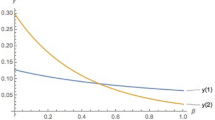Summary.
We compare simultaneous versus sequential moves in R&D decisions within an asymmetric R&D/Cournot model with linear demand (for differentiated products), general R&D costs, and spillovers. Simultaneous play and sequential play (with and without a specified leader) can emerge as appropriate formulations, depending on the ratios of spillover rate over demand cross-slope, but not on R&D efficiency. When at least one ratio is above 1/2, a sequential solution mitigates competition and leads to higher profits for each firm, and to higher social welfare. When uniquely specified, the stronger firm emerges as the R&D first-mover.
Similar content being viewed by others
Author information
Authors and Affiliations
Additional information
Received: December 8, 1997; revised version: October 25, 1998
Rights and permissions
About this article
Cite this article
Amir, M., Amir, R. & Jin, J. Sequencing R&D decisions in a two-period duopoly with spillovers. Econ Theory 15, 297–317 (2000). https://doi.org/10.1007/s001990050014
Issue Date:
DOI: https://doi.org/10.1007/s001990050014




